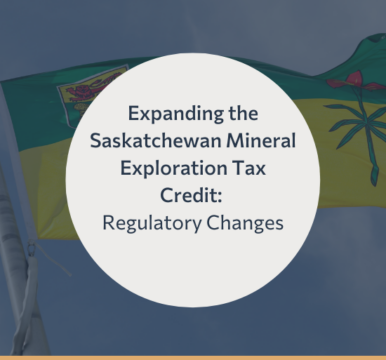This submission to the Federal Government was provided by PearTree on Friday, February 9, 2024. Below we list and expand upon our recommendations for the 2024 Federal Budget.
List of Recommendations
Recommendation 1: Expand the definition in the Income Tax Act to make the Clean Investment Tax Credits and all 31 minerals on Canada’s Critical Minerals List eligible for financing under the Flow-Through Share (“FTS”) tax regime with a priority placed on helium.
Recommendation 2: Renew the Mineral Exploration Tax Credit for 5 years beyond the current expiry date of March 2024, and extend the Critical Mineral Exploration Tax Credit by 2 years, from 2027, thereby aligning the periods for the two incentives.
Recommendation 3: Provide authority to the Minister of Natural Resources to allow for an extension of expenditure timelines associated with FTS in the event of an unforeseen situation (e.g. wildfires) that may create unintended tax consequences for companies and individuals.
Recommendation 4: Postpone implementation of the proposed changes to the Alternative Minimum Tax (“AMT”) to be effective January 1, 2025 to allow for continued consultation and refinement in order to avoid foreseeable and potentially catastrophic impacts on the resource and charity sectors.
Recommendation 5: Modify the proposed changes to the AMT in Budget 2023 to reduce or eliminate the unintended negative economic impact on the successful Mineral Exploration Tax Credits by:
- Removing the Donation Tax Credits from the AMT calculation
- Retaining the 0% inclusion rate for capital gains on donations of publicly listed securities in the calculation of AMT
- While preserving the regular capital gains treatment for FTS based on a deemed nil adjusted cost base, for the purpose of AMT only, the capital gain calculation should be based on the subscription price paid for the FTS and not nil.
Recommendation 6: Clarify the language in proposed subsection 245 (4.1) of the ITA surrounding the GAAR to ensure tax incentives supporting high risk investment in the FTS regime are not inadvertently eliminated resulting in negative economic impacts on the exploration sector by adding a postamble stating: “but does not include a transaction or series entered into for the purpose of issuing a flow-through share for which an information return has been filed with the Minister under subsection 66(12.68).”
Recommendation 7: Amend the ITA Regulation s.6201.1(5)(c) definition of ‘excluded obligation’ to increase resource issuer tax compliance. These provisions should apply to all FTS offerings.
- Issuers’ obligations under the standard FTS tax indemnities contained in subscription agreements should include interest charged by the CRA to FTS subscribers.
- The indemnity obligation should be a first charge against the assets of the issuer in priority to banks but always subordinate to government claims.
Introduction
About PearTree
This submission is provided by PearTree Financial Services Ltd. and its wholly owned subsidiary PearTree Securities Inc. (collectively “PearTree”). PearTree was founded in 2007 now employing approximately 40 individuals and is the leading source of mineral exploration capital exclusively funding Canadian projects. Annually, PearTree funds over $500 M, in more than 60 financings, all within the FTS tax incentive regime.
PearTree is the largest single source of exploration capital in Canada, has the data to support all the statements made in these submissions and will provide further disclosure upon request.
About Flow-Through Shares
FTS financings represented 83% of all capital raised for Canadian resource exploration in 2023. FTS financings are restricted to funding on the ground mineral exploration and development projects in Canada. In most years, over $1 B is raised in the public capital markets and deployed on mineral exploration projects in northern and remote regions of Canada.
A FTS is a newly issued common share in which the issuer agrees to spend the funds raised on direct exploration activities as defined in the Income Tax Act (Canada) (“ITA”) – mainly labour and services in northern and remote communities. Business expenses and tax deductions normally available to any corporation incurring expenses are flowed through to the subscribers funding the activity. The net outcome is a dollar of tax deduction by the urban FTS subscribers results in a dollar of taxable activity largely deployed in northern regions.
For the earliest stage exploration, the federal government and several provinces provide additional tax credits to incent high-risk investment. Historically, the federal government has provided a 15% Mineral Exploration Tax Credit (“METC”) which is available on the issuance of FTS funding most minerals, including gold. For example, if an investor were to purchase $10,000 of FTS funding exploration for gold, the investor deducts $10,000 in the year of investment as Canadian Exploration Expense (“CEE”) and in addition claims a 15% or $1,500 METC – a full credit not a deduction against federal taxes otherwise owing. In the year following, the investor / taxpayer adds back the $1,500 credit as income on their T1 return, reducing the net tax METC incentive to about 7%.
Similarly, the 30% Critical Mineral Exploration Tax Credit (“CMETC”) introduced in the 2022 budget applies to FTS financings exploring for 15 critical minerals including lithium, cobalt, and copper works the same way. The same investor for $10,000 in FTS funding lithium exploration will deduct $10,000 against income and in addition claims a 30% or $3,000 CMETC against their federal taxes owing. This is reduced to less than 14% for those taxed at the highest tax bracket the following year when the credit is added back into income. In the 18 months following the introduction of the CMETC in budget 2022 over $500 M was raised for critical mineral exploration as a direct result of introduction of the CMETC.
Concentration Risk – Very few Taxpayers Fund Most all Exploration in Canada – according to the CRA website data for 2021, 14,400 taxpayers earning taxable income over $250,000 and thus all subject to AMT funded $1.06 B in exploration or 88% of all FTS exploration in Canada which in turn funded nearly 90% of all exploration funding including FTS, debt or otherwise. If one were to add to this group those earning $150,000 to $250,000 the percentage funded, increases to 94%. To the extent that the threshold income under the proposed AMT is $173,000 it’s reasonable to assume after two years of inflation that the majority of taxpayers earning above $150,000 in 2021 will be now subject to AMT.
Convergence Risk – A very small subset of the 14,400 flow-through subscribers referred to above, fund a majority of all exploration in Canada. For example, in the 12 months following the introduction of very successful Critical Mineral Exploration Tax Credit in April 2022, PearTree funded $225 M of FTS funding critical minerals on behalf of fewer than 1,100 clients representing 64% of all critical mineral exploration financings under the FTS regime.
PearTree was founded in 2007 upon the issuance of the CRA Advance Income Tax Ruling updated after a change in law in 2011 (“Rulings ») and available on the PearTree website. The PearTree structure is now the fundamental way in which nearly all FTS financings are completed in Canada in a simple three step structure in which FTS subscribers immediately donate the FTS with the charities immediately selling the shares to global investors at a discount to market stripped of tax value.
The PearTree structure provides Canada with an investment pricing advantage over every other country. This approach is best understood by the Quebec government where additional tax incentives to the FTS regime in combination with CMETC have resulted in significant Australian investment in Quebec through PearTree including Sayona Mining and Patriot Battery Metals.
Unfortunately, this form of financing is particularly sensitive to AMT since a FTS has a deemed zero value for tax purposes resulting in a capital gain, even where there is an economic loss. The combination of the new AMT rules targeting capital gains and donations result in a foreseeable reduction in resource exploration financing of not less than a third and materially less donated to charities.
Expand Flow-Through Eligibility
Recommendation 1: Expand the definition in the Income Tax Act to make the Clean Investment Tax Credits and all 31 minerals on Canada’s Critical Minerals List eligible for financing under the FTS tax regime with a priority placed on helium.
Discussion:
The Government of Canada has ambitions goals to achieve reductions in greenhouse gases by 45% by 2030 and to achieve net-zero emissions by 2050. In order to support investments in the clean economy, the government announced five new or expanded Tax Credits in Budget 2023.
- A 15% refundable Clean Electricity Investment Tax Credit
- Refundable Clean Technology Manufacturing Tax Credit, covering 30% of costs in new machinery and equipment
- The Clean Hydrogen Investment Tax Credit, supporting 15-40% of eligible project costs
- Expanding the Carbon Capture, Utilization, and Storage Investment Tax Credit
- Expanding eligibility for the refundable Clean Technology Investment Tax Credit
Based on the success of the FTS tax regime over the past 50 years, one of the longest standing tax regimes in Canada, and more recently the immense success of the FTS tax regime in combination with the CMETC we know these tax incentives work and are cost effective.
The flow-through tax regime does more than just incent investment, it enables companies to raise money in the public markets. When projects are eligible for flow-through, at least half of the risk is taken by the taxpayer (investors). For example, Government can choose to invest $1 B to incent the construction of a battery plant. $ 1 B which represents $3 B of taxable income collected at 33%. In the flow-through regime to incent the same level of investment, the public invests the $1 B and the cost to government is $333 M of lost tax revenue. The cheapest and fastest way for government to fund the green transition is the expansion of the flow-through regime. There are billions to be saved by treasury. Clean electricity, clean technology, clean hydrogen, and carbon capture should all be eligible for FTS financing as a dollar for dollar deduction. In PearTree’s view no additional tax credits such as METC or CMETC are required to promote these investments.
Canada has identified 31 critical minerals that are vital to supporting economic growth, competitiveness, environmental protection, reconciliation, and enhancing global security. For Canada to take its rightful position as global leaders in the fight against climate change, it needs to commit to exploring, extracting and processing these critical minerals. Helium for example, is found deep (~2km) in the earths crust, in “bedded deposits” and thus not flow-through eligible. Canada has 5% of the world’s helium resources, but only supplies 2% of the world’s helium. Considering Canada’s helium is produced alongside nitrogen as opposed to hydrocarbons like many other countries, Canada’s helium would be sought after and demand a market premium for its lower carbon footprint. The helium supply chain is rapidly changing. The US, the global leader, is quickly becoming a net importer as their resources are depleting and Russia, Qatar and Algeria are becoming ever more politically unstable as trading partners. Canada has the ability to secure its own supply of helium for use primarily in the medical and defence sectors, while also contributing upwards of 10% of the global helium market, creating a new and much needed supply chain for Canada. There are similar rationales for each of the 16 critical minerals on Canada’s list that are not currently eligible for the CMETC. Each are important to Canada’s economy and could have a larger, more significant positive impact on rural economic development and reconciliation, if they were flow-through and CMETC eligible with little if any CRA administrative burden especially if Recommendation 7 is adopted.
Exploration Tax Credits
Recommendation 2: Renew the Mineral Exploration Tax Credit for 5 years beyond the current expiry date of March 2024, and extend the Critical Mineral Exploration Tax Credit by 2 years, from 2027, thereby aligning the periods for the two incentives.
Discussion:
Grassroots mineral exploration is a high-risk business, with roughly 1 in 10,000 mineral showings ever advancing to become a new mine. Canada’s FTS regime is the primary source of investment capital in these non-revenue generating companies, bringing in more than 80% of funds raised for exploration companies listed on the Canadian public markets. The additional 15% non-refundable MTEC, helps to cover costs associated with operating in rural and remote areas of Canada with limited infrastructure, the cost of labour, and costs associated directly with advancing geological knowledge of a specific target.
The CMETC has been successful since inception to incent exploration companies to explore for the minerals that are considered higher risk. They occur in smaller volumes, at lower concentrations, are more difficult to find, or simply less is known about the deposit styles.
Both tax credits have proven to be extremely effective at directing and encouraging work of the sector in a direction that supports government initiatives, including current climate actions goals. Exploration activity has been declining since 2008 from ~45% of Canadian mining activity to ~22% in 2022. In addition, the industry is facing weak commodity markets, staffing shortages of skilled labour and increases in the costs of supplies. As these factors compound, the need for industry to have long term certainty that the METC and CMETC will continue is paramount.
According to the Prospectors and Developers Association of Canada, the government estimates the cost of the METC to the public was ~$425 M between 2019 and 2022. However, this was more than offset by the $3 B in capital raises using the METC over the same time period. Based on Government’s own evaluation, the $3 B translates into $8.5 B in exploration related expenditures across the country, or a 20 times positive impact on the Canadian economy.
The METC and CMETC are proven effective tax incentives helping industry achieve their goals while ensuring the Canadian government can continue to move towards meeting its climate goals and commitments for a greener, low carbon future.
Wildfires and Expenditure Timelines
Recommendation 3: Provide authority to the Minister of Natural Resources to allow for an extension of expenditure timelines associated with FTS in the event of an unforeseen situation (e.g. wildfires) that create significant liabilities for resource companies and their FTS investors.
Discussion:
As the climate continues to change, disruptive natural phenomena are more prevalent. In 2023, Canada witnessed and unprecedented wildfire season, particularly in Quebec. In other, parts of the country there were massive flooding events, atmospheric rivers that lasted for days, landslide that cut off access to communalities for weeks and increased tornado warnings.
Mineral exploration requires access to the land, and remote projects sites by back roads and trails or by helicopter. The fires in Quebec last year cut access to project sites by issuing evacuation orders for more than 2 months at the height of the exploration season. The government then seconded heavy earth moving equipment and helicopters to aid in the fight against the fires. As an industry, exploration companies understand the importance of health and safety and diligently comply with emergency evacuation orders. Many companies sent people to help fight the fires or to build firewalls in an effort to protect small communities that larger firefighting teams couldn’t reach. The industry came to a halt as a result of the fires and government edict. Unfortunately, in not spending the funds within the required period under the FTS regime, exploration companies face penalties and tax liabilities.
For example, in 2023 a Quebec based explorer was restricted from accessing their property for 2 months due to the wildfire evacuation order. It was unable to complete its ground-based exploration work, needed to identify drill targets due to the lack of access and within the time lines required under the flow-through share tax incentive regime. In addition, their helicopter was seconded to help fight the fires, so they were unable to complete their airborne geophysical work. As a result, the company was unable to meet the expenditure requirements and are now being penalize under extreme circumstance not of its making.
The exploration company was $2.83 M short of their exploration expense requirement. Under the FTS regime the exploration expense (CEE) is flowed through to the first subscriber from treasury of the FTS funding new exploration and within a very short time line. Since the company was prohibited and unable to access its site, the CEE was not incurred. As a result, it now needs to pay an indemnity to the FTS subscribers of $2.27 M (including the provincial portion) or 80% of the capital raised. On top of this they will have to pay other taxes and interest. Because this is a Quebec based project, the resource issuer may take advantage of the relief program that is offered in Quebec, this removes the Quebec portion of the indemnity but requires a company to still spend the exploration dollars. In this case, the company would still have to pay the federal indemnity of $1.39 M, and the required exploration spend of $2.8 M, a total cash outlay of $4.22 M, or 150% of the capital raised. The lack of relief by a simple extension of time required from the federal government in line with the Covid extensions is unfair to resource companies, their investors, and renders the Quebec relief program ineffective. In addition to the financial impact on the company, this situation is souring both Canadian FTS investor sentiment as well as global investors who buy the shares on closing under the donation arrangement otherwise discussed in this submission. This entire situation is avoidable if the Minister had the ability to make a case by case decision to provide relief to the company, and/or to companies in the area.
Alternative Minimum Tax
Recommendation 4: Postpone implementation of the proposed changes to the Alternative Minimum Tax (“AMT”) to be effective January 1, 2025 to allow for continued consultation and refinement in order to avoid foreseeable and potentially catastrophic impacts on the resource and charity sectors.
Discussion:
The proposed changes to AMT in Budget 2023 were to be effective January 1, 2024. However, the date has passed, and no legislation tabled. This has resulted in uncertainty and an abeyance in resource exploration financings and donations.
Resource financing under the FTS tax regime is down by more than 60% over Q1s in previous years. AMT uncertainty is the major factor, exacerbated by a downturn in commodity prices. Canada has lost its pricing advantage in attracting global investment for critical minerals and exploration more broadly, slowing its pace to reach climate action and electrification goals.
Donations using FTS and more broadly the donation of publicly listed securities are also down prejudicing charities where major gifts are paid in multi-year pledges. Donors are holding off 2024 pledge payments committed to in previous years awaiting clarity to the AMT rules.
Since the budget is unlikely to be tabled before mid-March it is only appropriate for changes in AMT to be made effective January 1, 2025 to allow for continued consultation and refinement to allow charities to collect under multi-year pledges and to avoid significant reduction in financing critical mineral and other resource exploration which is entirely foreseeable.
Recommendation 5: Modify the proposed changes to the AMT in Budget 2023 to reduce or eliminate the unintended negative economic impact on the successful Mineral Exploration Tax Credits by:
- Removing the Donation Tax Credits from the AMT calculation
- Retaining the 0% inclusion rate for capital gains on donations of publicly listed securities in the calculation of AMT
- While preserving the regular capital gains treatment for FTS based on a deemed nil adjusted cost base, for the purpose of AMT only, the capital gain calculation should be based on the subscription price paid for the FTS and not nil.
Discussion:
AMT is a feature of the ITA designed to ensure that all taxpayers remit a minimum amount of tax relative to income in any one year, even though a taxpayer may have participated in tax incentive transactions, such as FTS, which could otherwise potentially reduce one’s taxable income to nil. Current AMT rules already limit the effectiveness of the FTS regime. The proposed changes to the AMT will further dis-incent FTS investment.
Tax Incentives Work – In the first 12 months of the CMETC beginning in April 2022, PearTree funded 64% of all FTS financings in critical minerals ($225 M / $350 M). The average FTS subscription by PearTree clients across all provinces was $239,000. Approximately 1,100 subscribers funded 64% of all FTS critical mineral exploration programs. While AMT impact varies by province and investor income, in order to invest $239,000 in FTS in 2022 / 2023 the taxpayer required approximately $800,000 in high-rate T4 income. Under the proposed AMT rules the same taxpayer will require a minimum of $1.2 M of taxable T4 income to make the same investment. Alternatively, had the proposed AMT rules been in effect in 2022 the same investor would have only invested $159,333. By extension the $350 M of FTS raised using the CMETC would have been reduced to $232 million, a loss to the Canadian economy of $118 M in exploration activity – fewer jobs in rural and remote communities and a lesser likelihood of finding critical mineral deposits of size and quality to warrant much needed mine development for our greener future.
Under the new AMT rules the recalculation of taxable income for a year adds back into income 100% of capital gains on the donation or sale of FTS with a deemed tax value of nil, and allows for only 50% of all non-refundable tax credits to be deducted including donation tax credits, and adds back 30% on the donation of publicly listed securities. These provisions, in tandem with the rate increase, materially limit the FTS tax incentive, since it significantly reduces (and possibly eliminates) the room to absorb the CMETC / METC in the year of investment. Based on the current architecture of the ITA, the deductibility / recognition of federal investment tax credits – whether 15% METC or 30% CMETC – is limited to the difference between taxes otherwise owing and the AMT calculation.
In the FTS regime, immediately upon subscription for the FTS, the adjusted cost base (“ACB”) is deemed to be nil for tax purposes. The rationale being that the taxpayer fully deducted the cost of the FTS. However, holistically a $1.00 of tax deduction results in a $1.00 of taxable activity in northern communities. The fiscal authority is materially whole. The capital gains tax paid when the shares are sold (or donated) recoups any tax revenue leakage including the METC or CMETC. A FTS purchased at a $1.00 if sold for 60 cents will still attract a 60 cent capital gain and attendant tax. We are not advocating for the elimination of the capital gains tax even though the gain is a construct of the ITA, but rather we recommend that the capital gain calculated from a deemed nil cost up to the purchase price, not be included in the AMT calculation.
General Anti-Avoidance Rule (“GAAR”)
Recommendation 6: Clarify the language in proposed subsection 245 (4.1) of the ITA surrounding the GAAR to ensure tax incentives supporting high risk investment in the FTS regime are not inadvertently eliminated resulting in catastrophic economic impacts on the exploration sector by adding a postamble stating: “but does not include a transaction or series entered into for the purpose of issuing a flow-through share for which an information return has been filed with the Minister under subsection 66(12.68).”
Discussion:
The purpose of the GAAR is to counteract tax arrangements that have been implemented primarily for the purpose of obtaining tax benefits, which, when viewed objectively, are not consistent with the underlying policy or intent of the relevant tax laws. It is intended to target transactions or arrangements that, while technically legal, are seen as abusive attempts to reduce or eliminate tax liabilities in ways that lawmakers did not intend.
The recent amendments to the GAAR introduce significant uncertainty for FTS financings and the realization of the fiscal and economic objectives intended through the METC and CMETC. The analysis of FTS transactions in the context of the GAAR confirms that GAAR should not apply to the subscription, sale or donation of FTS considering the nature and rationale of related tax incentive provisions in the ITA. As the initial Department of Finance’s Explanatory Notes for the GAAR indicates, it is not intended that “tax incentives expressly provided for in the legislation would be neutralized by [the GAAR].” The mining industry has significant concerns that the GAAR, if amended, might invalidate legitimate tax benefits derived from FTS financings by investors, especially in circumstances where the value of tax benefits exceeds the economic returns from investments (although this asymmetry is inherent to many FTS financings).
Approximately 85% of all FTS financings are now completed in a series of transactions colloquially referred to as a flow-through donation financing. The ‘donation arrangement’ structure has been reviewed and supported by the CRA and Revenue Quebec in advance income tax rulings (https://peartreecanada.com/education/tax-rulings/) and is the foundational platform in attracting global exploration capital. In this approach, Canadian subscribers purchase FTS for immediate donation and sale. For example, in 2023 PearTree completed a $50 M financing for Sayona Mining Ltd, an Australian company mining and exploring for lithium in Quebec. While the FTS offering was for $50 M upon donation and sale stripped of tax value the shares were purchased by Australian investors for $32 M. In this approach the FTS regime bridges valuation gaps and enables a compelling made in Canada financing schema which sees foreign capital attracted to the proposition that $32 M invested results in $50 M of project- specific exploration activity and economic opportunity in Canada.
We believe there are sound justifications for the exclusion of FTS transactions from the newly proposed interpretive rules under the GAAR in order not to undermine the economic objectives of the FTS regime and its significant benefits for the Canadian economy. The simple carve out postamble we have recommended is similar to the existing wording under subsection 237.3(14) ITA in respect of reportable transactions. Given that issuers of flow-through shares are required to file information returns, the Minister would be provided with all required information to audit FTS arrangements and preserve its ability to enforce the ITA.
Resource Issuer Tax Compliance
Recommendation 7: Amend the ITA Regulation s.6201.1(5)(c) definition of ‘excluded obligation’ to Increase Resource Issuer Tax Compliance. These provisions should apply to all FTS offerings.
- Issuers’ obligations under the standard FTS tax indemnities contained in subscription agreements should include interest charged by the CRA to FTS subscribers.
- The indemnity obligation should be a first charge against the assets of the issuer in priority to banks but always subordinate to government claims.
Discussion:
Keeping tax legislation current across all sectors is a challenge, however the prescribed share rules which govern the FTS regime have not been materially changed in decades even though the market has changed significantly. The METC and CMETC incents taking on investment risk but mandates the use of funds on a short list of exploration activities. If the resource issuer fails to properly spend the funds raised under the FTS regime, the FTS subscriber funding the activity will be denied the tax expense deductions and credit. Upon reassessment of FTS subscribers by the CRA for failure by the issuer to renounce or properly spend exploration expenses, the current case law limits issuer tax indemnities to investors to the tax owing and not with respect to interest charged by the CRA to the FTS investors. The CRA has six years to reassess and if the CRA denies exploration expenses, it charges the FTS subscriber non-deductible interest at the prescribed rate plus 4%. As of today, that non-deductible rate is approximately 9% or a pre-tax equivalent of over 19%. We have seen FTS tax reassessments in which over a quarter of the tax owing is on the account is interest and this has been during a period of very low interest / prescribed rates. Investment in FTS offerings is venture capital at the riskiest end of the continuum. For expenditures to qualify as CEE and by extension to be eligible for the tax credits, issuers need not be successful in the exploration program. Management simply has to comply with tax legislation, particularly with respect to the use of CEE funds as set out in the ITA. Due to the cyclical nature of exploration cycles many issuers do not have the ability to honour the tax indemnities years later. The current schema needs revision. The two amendments set out in our recommendation above will go a very long way in driving compliance by issuers and in doing so support the METC and CMETC incentives, while adding an element of investor appreciation with a fairer tax regime whilst reducing the CRA workload.
Please direct questions or comments to Kendra Johnston, Managing Director, by email: kendra.johnston@peartreecanada.com.








